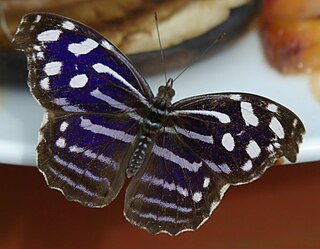
Papilio is a genus in the swallowtail butterfly family, Papilionidae, as well as the only representative of the tribe Papilionini. The word papilio is Latin for butterfly.

Jacob Hübner was a German entomologist. He was the author of Sammlung Europäischer Schmetterlinge (1796–1805), a founding work of entomology.

The Satyrini is one of the tribes of the subfamily Satyrinae. It includes about 2200 species and is therefore the largest tribe in the subfamily which comprises 2500 species.

Biblidinae is a subfamily of nymphalid butterflies that includes the tropical brushfoots. This subfamily was sometimes merged within the Limenitidinae, but they are now recognized as quite distinct lineages. In older literature, this subfamily is sometimes called Eurytelinae.

Miletus is a genus of butterflies sometimes called brownies. Its species are found in the eastern Palearctic realm and the Indomalayan realm, and some stray east of the Wallace Line. The genus was erected by Jacob Hübner around 1819. Miletus is the type genus of the subfamily Miletinae.

Danaus, commonly called tigers, milkweeds, monarchs, wanderers, and queens, is a genus of butterflies in the tiger butterfly tribe. They are found worldwide, including North America, South America, Africa, Asia, Indonesia and Australia. For other tigers see the genus, Parantica.

Doxocopa is a genus of Neotropical butterflies in the family Nymphalidae, subfamily Apaturinae. It includes the following species:

Gonepteryx is a genus of butterflies in the family Pieridae; there are about 15 species of Gonepteryx. They live in Europe, Asia, and Northern Africa. They are commonly known as brimstones for the bright yellow colour of the wings of most species. These share the same name as the much larger tropical genus Anteos. These inhabit much of central and South America and also North America. This species are known for being the kings of butterfly longevity. 10–13 months is the lifespan for many temperate species. Anteos, however, is much shorter lived. The adults will often mimic ivy leaves at rest. Male brimstone butterflies can withstand cooler temperatures and are able to fly after just 4 months in hibernation. Female brimstone butterflies need warmer climates to survive, and therefore are in hibernation longer. The male butterflies have a longer life span as they are more resilient to a wider range of temperatures, unlike the female.

Faunis is a genus of Asian butterflies in the family Nymphalidae. They are among the butterflies commonly known as fauns. They are relatively small-sized amathusiins, subtly colored in soft browns and violets, and range from China to the Philippines and Sulawesi.

Drupadia is a butterfly genus in the family Lycaenidae. They are commonly known as posies. The members (species) of this genus are found in the Indomalayan realm.

Memphis, described by Jacob Hübner in 1819, is a Neotropical nymphalid butterfly genus in the subfamily Charaxinae.

Uranophora is a genus of moths in the family Erebidae. The genus was erected by Jacob Hübner in 1831.

Dismorphia is a genus of butterflies in the subfamily Dismorphiinae.
Helia is a genus of moths in the family Erebidae. The genus was erected by Jacob Hübner in 1818.

Prioneris is a genus of butterflies in the family Pieridae found in the Indomalayan realm.

Antirrhea is a Neotropical genus of butterflies from the family Nymphalidae.

Euptychia is a genus of satyrid butterflies found in the Neotropical realm. The genus was erected by Jacob Hübner in 1818.

Zeuxidia amethystus, the common Saturn, is a species of butterfly in the family Nymphalidae. It was described by Arthur Gardiner Butler in 1865. This butterfly is relatively large and striking. Its forewings have a broad iridescent-blue band with a similar blue patch on the hindwing. It is not abundant in Thailand, Malaysia, Sumatra and Borneo. It has only be observed in dense forests. It can be approached while feeding on fermenting fallen fruits. Its flight period extends from May to September. It obtains minerals using mud-puddling behavior and seem to be prefer ammonium ions rather than sodium.

Zeuxidia doubledayi , the Scarce Saturn, is a large butterfly that belongs to the Morphinae group of the family Nymphalidae. It was described by John Obadiah Westwood in 1851. It is found in the Indomalayan realm.


















